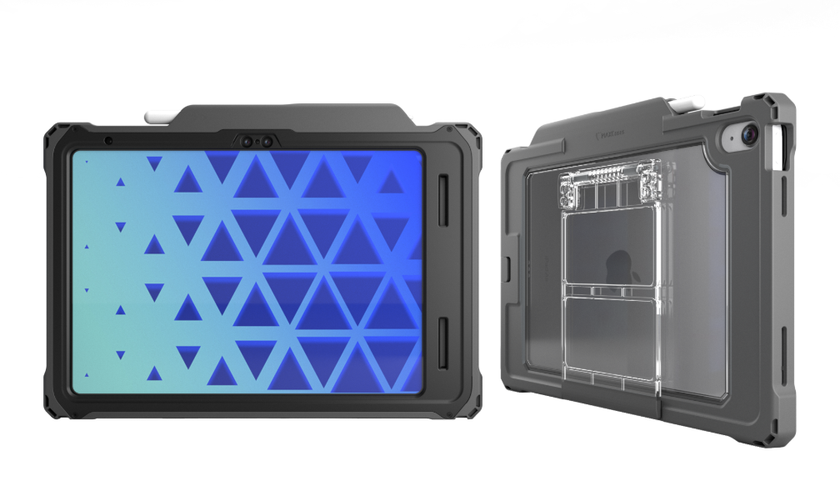FUTURE ROOMS: THE INTELLIGENT USE OF SPACE
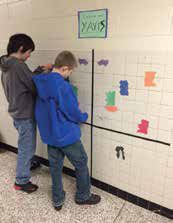
Surely you’ve heard the not-so-funny joke that if Rip Van Winkle were to wake up today he’d recognize only one thing: the classroom, with its cookie-cutter rows of desks and a blackboard and teacher up front. But we all know that mobile devices allow digital learning to take place anywhere—on a bus, a beach, a bed, or at a ball game. That’s why some districts are turning their libraries, unused closets, and classrooms into open, collaborative spaces that better reflect the open, collaborative learning of today.
At Albemarle, students turn walls into graphs, libraries into collaborative learning spaces, and cafeterias into tree houses.
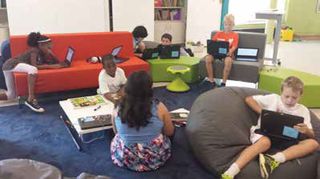
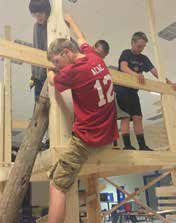
“It really is a mindset shift,” says Tom Murray, state and district digital learning director for the Alliance for Excellent Education (www.all4ed.org). “There’s a disconnect if the spaces don’t practice what we preach in terms of the 21st-century skill set.”
Murray suggests starting with one room or area, often a library. Ask for student input to figure out the needs of the building, your culture, and your community. “Redesign does not need to include expensive, high-priced furniture,” he says. “Take cues form HGTV’s ‘Design on a Dime;’ ask for donations, check out garage sales, reuse old furniture.”
Need a little inspiration? Check out what these four districts have done.
DIY SPACES FOR CROSS-CURRICULAR STEM
High school students pay attention in Elizabeth’s Forward’s Entertainment Technology Academy classroom (top & bottom left); middle school students learn about fractions in the SmalLab. “We’ve tried to focus on every space—floors, ceilings, walls, hallways, classrooms, gyms, libraries, cafes—and ask, ‘How can we design this so students are able to see themselves as learners where they go?” says Pam Moran, superintendent of Albemarle County (VA) Public Schools and 2016 Virginia Superintendent of the Year.
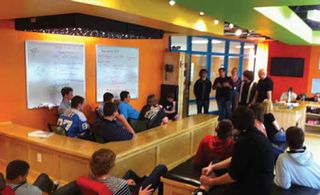
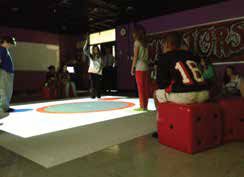
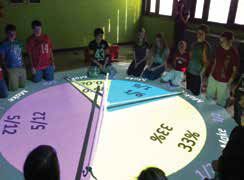
From letting students draw on hallway tiles to create bar graphs and spreadsheets to putting old lawnmowers in the library for students to rebuild, Albemarle does everything it can to encourage students to be makers.
The redesigning efforts started six years ago to make STEM work more accessible to everyone. In 2010, administrators turned a closet in a high school library into a music studio/maker space. “We bought 3D printers and then filled the tool cabinet with stuff from people’s garages, including sewing machines, glue guns, drills, and soldering irons,” says Ira Socol, assistant director for educational technology and innovation. “Students stop in to invent things and solve problems.”
The newest learning space, in an elementary school, has no walls and can house up to 120 students and six teachers. “Every surface, including the floors and windows, is writeable, and there’s a full kitchen,” says Ira Socol, assistant director for educational technology and innovation. Rather than participating in an Hour of Code, the district weaves coding into cross-curricular projects all year long. Already this year, students have cooked Thanksgiving dinner and designed Hovercraft chairs.
The middle schools have mechatronics labs. The people running the labs partner with science, art, physical education, and other teachers to do interdisciplinary projects. Last year, the students decided they didn’t like their cafeteria so they built 16-feet, two-story, rolling tree houses. As Moran says, that’s the type of learning they will never forget.
“If you change the space, it’s easier to change the learning,” says Moran. “When I walk into a library and a student tells me he wants to use a drone he built to help the librarian hang banners on a 40-foot ceiling, that’s a great feeling.”
BRIGHT COLORS, REVAMPED SPACES, AND ENERGIZED STUDENTS
Evanston students get hands-on manufacturing practice in state-of-the-art labs. Back in the fall of 2011, the superintendent and assistant superintendent of Elizabeth Forward (PA) School District visited Carnegie Mellon University’s (CMU) Entertainment Technology Center, where CMU students study game design, interactive storytelling, robotics, and more. That’s when they knew they needed to do something about their uninspired white walls and rows of desks if they wanted to keep students engaged.
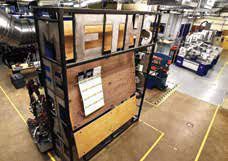
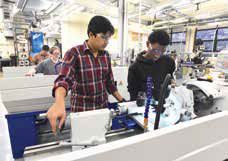
Using a $10,000 grant from The Grable Foundation, they turned a computer lab at the high school into a colorful open space with flat-screen TVs, pop art, roller chairs, and a big table. Now students choose from 12 one-semester courses in programming, storytelling, or digital art and leave high school with a portfolio, a game or product they’ve developed, and a Certificate of Accomplishment.
This project’s success fueled several others, mostly funded by grants, including a Situated Multimedia Arts Learning Lab (SMALLab) in the middle school—the only one in the U.S. “We painted the walls purple and green, hung Andy Warhol art, and installed 12 cameras and a projector into an open ceiling,” says Assistant Superintendent Todd Keruskin. In this multimedia arts learning lab, students use their bodies to learn about language arts, math, and science.
Project-based learning and hands-on activities make science fun for Deerfield students. Other projects include turning the high school library into a media center with a TV studio, recording studio, and café; and opening the middle school’s Dream Factory, where students use laser cutters, 3D printers, microcontrollers, and wood shop equipment to learn about art, design, computer science, robotics, engineering, and programming. For one project, students developed and printed their own candy cars in 3D, created vacuum molds, and designed wrappers with nutritional information in Photoshop. Then they made commercials.
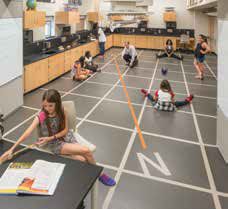
Before all of these changes, 70 students had left the district for charter or cyber schools. Today, that number has dropped to 14. “Our teachers say the creative spaces allow them to think and to teach differently—they’re more relaxed, and so are the students,” says Keruskin.
MANUFACTURING LABS COME OF AGE
After recognizing the need to build more open spaces and enhance their STEM offerings and the appeal of STEM, Evanston Township (IL) High School District 202 opened two new STEM labs at the start of last school year. “We’re a 1.3 million-square-foot high school with three miles of hallways, but we wanted to embrace the new state of the art,” says Eric Witherspoon, superintendent.
Although the district has been offering STEM courses through Project Lead the Way for 10 years, there was not enough emphasis on manufacturing. So they committed to that program and built a manufacturing lab that includes a metal sculpture and welding lab. “We updated very old stuff with lathes, 3D printers, and other items,” says Witherspoon. “We had to get current on manufacturing.”
An expanded, more advanced manufacturing lab was also renovated to include an automated tool control center, a computer numeric control lathe, drill presses, vertical milling machines, modern welding booths, and 3D printers. This lab offers additional STEM opportunities as well as multiple learning opportunities in 3D modeling, automation, programming, and robotics.
Both of the manufacturing labs were funded by donations through the district’s educational foundation and came largely from alumni and local manufacturers.
“Every students needs a high bar of training for college and career readiness,” says Witherspoon. “We’re pleased to offer pathways for everyone.”
RENOVATED LABS AND HANDS-ON LEARNING
In 2013, when Superintendent Mike Lubelfeld came to Deerfield (IL) Public Schools District 109, he put together a task force to look at the middle schools. The group recommended redesigning the 12 science labs in both middle schools to be STEM-ready and replacing home economics and computer apps with a STEM and communication/media arts courses. Around that time, the district also started a 1:1 program with devices and training for grades K through 8.
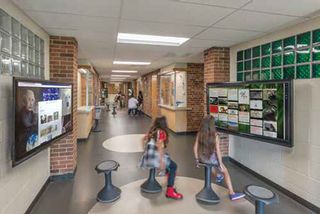
To make sure the middle school labs were renovated properly, Lubelfeld formed a 140-member task force of teachers, parents, students, and community members. The teachers wanted to use Next Generation Science Standards in a modern learning space, and the students wanted hands-on labs and true experimentation. They also expressed interest in learning about engineering.
The new labs, which are open and bright, have an area with small tables for collaboration and another area for experiments. Lighting is energy efficient and there are energy dashboards that show solar panel electricity, wind turbine electricity, and other measures of real life science. “Every centimeter of the labs is about learning,” says Lubelfeld. “Instead of reading about science from textbooks, our students now do project- and problem-based learning.”
Funding came through general state aid that Lubelfeld put in a capital construction, longterm bonds for long-term facility improvements, and refinancing old debt at more favorable interest rates.
STEM TOOLS THEY USE
ALBEMARLE COUNTY (VA)
► Autodesk software
► Edgerton Center 3-D Printing
► Fable vision Learning Fab@School Maker Studio
► Makerbot Thingiverse
► Maker Shed Robot Kits
► MakeToLearn Silhouette 2D Fabricator
► MinecraftEdu
► Noticing Tools
► Ozobot Kit
► Scratch
► Smithsonian Invention Kits
STEM TOOLS THEY USE
EVANSTON TOWNSHIP (IL)
► Autodesk Inventor
► Bridgeport Mills
► Haas SL-10 Lathe 2001
► Knuth Basic 180 Super manual Lathes
► MasterCAM
► National 250 Hydraulic Shear
► Robot C
► Torchmate 4x4 CNC Plasma cutting table
► Tormach 770 CNC mill
► VEX Robotics Kits
STEM TOOLS THEY USE
DEERFIELD (IL)
► Creative Learning Systems SmartLabs
► Defined STEM
► Discovery Education tech-books, streaming, and professional development
► Lego, makey makey, dot and dash, spehero, little bits
► Node Chairs & Verb Tables
► Steelcase
► TCI Bring Science Alive
Tech & Learning Newsletter
Tools and ideas to transform education. Sign up below.
